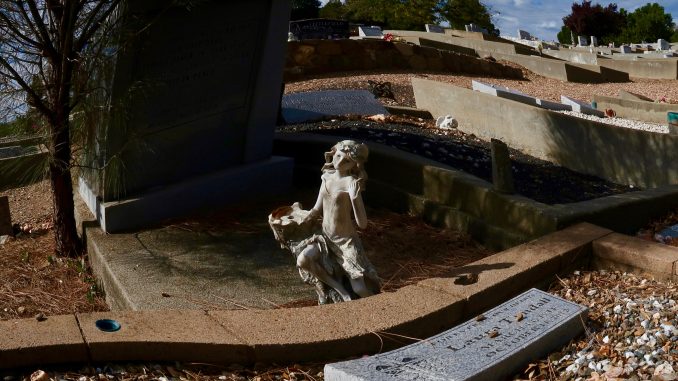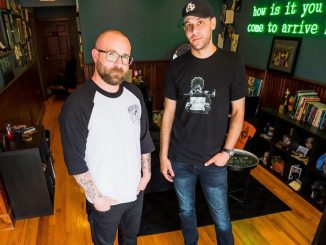
Working on the crime podcast ‘Trace of the Devastation’ meant revisiting events some would rather forget. But is forgetting them even possible?
By Scott Thomas Anderson
“I wasn’t sure how I felt about it,” Linda Toren told me, referencing the podcast series I’d just begun to release. “I was concerned that Calaveras County would be viewed as – that our only legacy would be this thing that happened. So, I went in with that, and I carried that with me as I listened … Perhaps some people who were deeply involved might feel, ‘Do we really need to go over this again?”
Hollywood writers love to imagine that digging into the past can disturb the dead – that it can somehow rouse them from their ground-mist slumber.
But the truth is when you excavate decades-old tragedies, and warm them with a media floodlight, it is not the victims moldering under the ground that you disturb, it’s the people they left behind.
In that sense, motivation is a fair question.
But purity of intention wasn’t what Toren was asking me about. She knew that I’d lived through the nightmare myself as a kid; and that – in a sense – my family was part of the story. In other words, I had skin the game, or at least a certain vulnerability that other reporters or would-be podcast phenoms lack when it comes to the near-unspeakable events we were dancing around.
Toren may not have been getting at my aims, but she was gently and thoughtfully questioning the stakes of re-mortifying an entire community, not to mention subjecting a younger generation to a trauma that it didn’t know about; and doing that through narrative details that no one – if decency means anything – should ever have to hear.
Was it worth it? What was the point of “Trace of the Devastation” supposed to be?
We were discussing this two months ago in a sapphire-painted cabin that sits on the high, buckling ridges of northeast Calaveras. Its window looks out on the remote, sparsely populated town of West Point. The little broadcasting hut has an obelisk-like antenna that gleams against the piney bulk of the tree line. It stands as the main structure that drivers notice when turning off the road, this bantam basecamp for 90.7 FM Blue Mountain Radio. And it’s one of only a handful of commercial buildings left in the hamlet that was the closest town to where I grew up.
It’s a polaroid fade, looking back now. I remember playing in West Point’s brush-studded meadows. I remember riding horses in its Lumber Jack Day Parade. I remember seeing restored Model-As rumbling on its main street, and men who were re-enacting being fur-clad trappers on their geldings – and I remember the then-alien smell of cheap beer splashing in the community hall. A different writer might use all that as grist for pondering mountain-time Americana; but today, I mostly think of West Point and its outpost of Wilseyville as map points that are smeared with a psychic and emotional blood-stain that can’t be washed from the land.
And it was this moment in time that Toren and I were chatting about over the mixing board of KQBM. I was 8 years old when all the murders happened. Toren, now the Poet Laureate of Calaveras County, was a young mom and teacher at West Point Elementary School. It would all come home for both of us and everyone else in the area: Two strangers from out of town had settled into a cabin in the backwoods and then started using it as a hellish hotbox for their vile personal fantasies. They kidnapped individuals, along with an entire family, from the Bay Area before taking them to the cabin. They abducted individuals, along with an entire family, from our town as well before bringing them to the cabin.
In no time at all, these two men turned a pastoral if impoverished hub of Sierra life into a forever field of torment and endings.
And one of them had come to my house three times when I was a kid.
After sixteen years of being a crime and investigations reporter, I found myself in the slightly uncomfortable position of having to interview my own mother and brother for the podcast to help explain how, and why, that happened. The risks of being alone with that man can’t be overstated, as the case files and court transcripts now bear out; but other people our family knew had more public brushes him. Toren’s husband encountered that man at the Wilseyville store several times. Two of my mom’s best friends had their own run-ins with him between Pioneer and Railroad Flat. Of the pair of strangers hiding their hideous deeds in a backwoods cabin, he was the one with the pathological over-confidence to be out and about – to be hunting for potential victims in the wide open.
Between that knowledge and the fact that he had been to my house on different occasions, it is perhaps not surprising that he came to take on an almost mythic presence in my thought process growing up.

“There’s other unfortunate things that have happened since then, though nothing quite so terrible,” Toren reflected at Blue Mountain Radio. “I lived here at that time. I knew some of the players as it unfolded in a horrifying way, and it was hard to put my mind around.”
Other unfortunate things? Absolutely. Calaveras County was part of my beat in the first five years I was a crime reporter. Towards the end of that stint, I received a national grant to study the ways that methamphetamine fuels crime in rural communities, and despite having the whole U.S.A. as my journalistic canvas, Calaveras became a constant beacon for much of what I wrote. Flash forward to today, I’ve now done fieldwork as a crime journalist in nine states and at least a quarter of California’s counties. And yet, even now, I have a certain feeling in the rare instances when I cover a crime saga in Calaveras that I don’t have anywhere else. There’s an inkling that the most darkly bizarre things that I might imagine could actually happen at any minute. Why does that gravity still remain? And why are those suspicions still occasionally proven out around West Point, despite the mind-numbing events of the 1980s have been over for so long now?
Damon Wyckoff – lead singer for the band Forever Goldrush – is my age and spent time in West Point as a kid. He says it’s not superstition that I’m feeling when I’m out there, it’s “an atmospheric river” of history and experience. It is the suffering that’s in the soil.
He feels it, too.
So does another guy from our age group, Josh Crabtree. He lived up the road when we were young and went on to become a highly decorated homicide detective at the Calaveras Sheriff’s Department. He’s in fact worked some of its biggest cases. So, that means Wyckoff grew up to be a songwriter who composes bruising murder ballads about the hills, and Crabtree grew up to investigate gruesome murders that continue to happen in them, and Google says that my algorithmic value as a human is as someone who grew into being a chronicler of death and tragedy. Was it all a coincidence? Or is there some link to what happened in Calaveras between 1982 and 1985 – and the forces that began conjuring that atmospheric river?
As a cerebral and attuned poet, Linda Toren understands my impulse to explore such questions. But she was still channeling the broader concerns of the community when she raised the topic of whether it was worth resurrecting painful memories for so many residents.
“So, people kind of take two views of that,” Toren observed. “There’s, ‘Yes, let’s take this as a cautionary tale, in a way.” But then other people think, ‘You know, let’s just forget about that.”
But my generation, Generation X, has never forgotten our near-misses with those two monsters – or what they did in the backwoods, on their wretched torture ranch.
As a journalist, I was curious about how the Boomer and Silent Generation folks of my hometown tried to deal with it in real-time; but I was more driven to understand how the down-stream power of it affected my own peer group. When we look back at the sepia photos of West Point at that time – particularly of its big Lumber Jack Day Parade – we see the old men in cowboy hats playing cards at tables; we see western saloon floats being hauled by 68 Chevys; we see parade queens in convertibles waving at kids in sun visors and denim overalls and second-hand Corduroy trousers. And for all we know, we are in those crowds along the mountain main street. And for all we know, so are the two monsters who lurked in the woods. Some people look at those sepia pictures now and see an evocative moment in time and space for rural living. We look at them and see a hunting ground peopled with still-framed, unknowing potential targets. Today there is a marble crypt in Calaveras’s Peoples’ Cemetery filled with 65 pounds of charred, unidentified human remains. The inscription on it read, “In Wilseyville we found, our lost ones, though taken in darkness, you will forever live in light.” My generation looks at those Norman Rockwell-esque sepia images and wonders who in the crowds might have been taken in darkness. It’s that disconnect – that discordance – that’s haunted us for all these years. Understanding that, and bearing witness to it, is why I wrote and produced “Trace of the Devastation.”
The first five chapters of the podcast series “Trace of the Devastation” are now live on iTunes/Apple Podcast and Spotify.


Be the first to comment